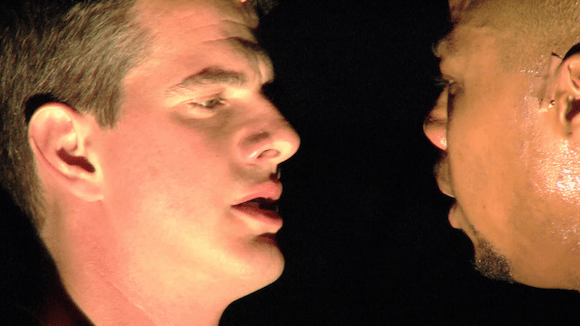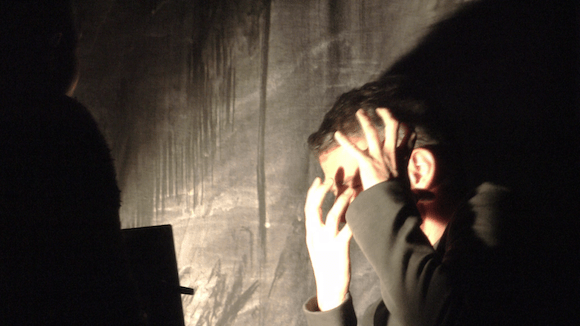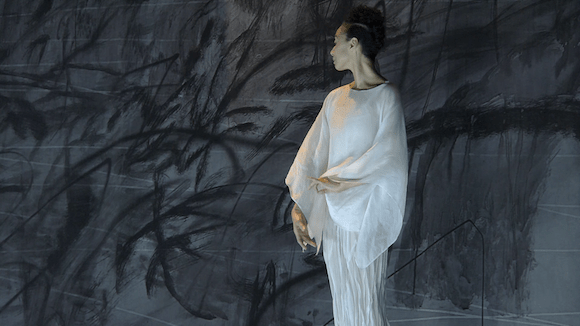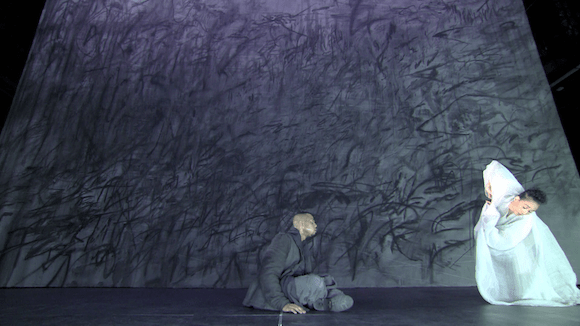Only the Sound Remains is a chamber opera by Kaija Sariaho based on two Noh plays translated by Ernest Fenellosa and Ezra Pound. The piece was premiered in Amsterdam in 2016 by Dutch National Opera, where it was recorded. It’s a co-pro with Teatro Real, Finnish National Opera and the COC so Toronto audiences will likely get a look at it eventually. Which is good because it’s really hard to figure out much of it from the video recording. As he so often does, Peter Sellars directs for both stage and camera and while I like his stage work here I find his video direction quite annoying, especially in the first piece.

So let’s look at the work and the staging. It’s in two halves. The first play is Always Strong (Tsunemasa); which is the story of a monk who summons the spirit of a lute player; dead in battle, through ritual and the dead man’s lute (represented in the score by the Finnish kantele. It’s followed by Feather Mantle (Hagoromo); the story of a fisherman who finds the cloak of a spirit who needs it to return to Heaven. Initially inclined to keep the beautiful object, the heavenly maiden offers to dance for him and he returns the garment. It’s all very stylized (of course) and often takes place on both sides of a scrim with projections and back lighting. For the second play, a dancer, naturally enough, joins the singers in some rather beautiful choreography. There’s some pretty intense acting, which we tend to see in gruesome close up, especially in Always Strong where it’s really hard to figure out the bigger picture. Things do improve though in Feather Mantle. It’s also very dependent on a complex and rather good lighting plot.

The music is very Saariaho though more in the vein of L’Amour de Loin than, say, Lonh. It’s a rich sound world combining string quartet, flute, percussion and kantele with electronics. It’s rich with natural sounds recalling bird song and running water. There’s also a four person chamber choir. In both pieces the mortal is sung by bass-baritone Davone Tines while the spirit element is counter-tenor Philippe Jaroussky. One could argue that that is a bit clichéd but it really works, especially with the stylized staging.

The performances are all excellent. Tines is a muscular baritone who injects considerable intensity into both his singing and acting which plays off against Jaroussky’s more ethereal sound, though his acting is no less intense. Nora Kimball-Mentzos dances beautifully and is truly redolent of an otherworldly presence. Instrumentalists and electronics blend nicely and are well co-ordinated by André de Ridder.

The Blu-ray release has the usual 1080p picture which is probably needed in the many rather dark scenes. There are LPCM stereo and DTS-HD-MA surround sound options. The surround track is noticeably more immersive which helps a lot with this music. There are no extras on the disk. The booklet contains synopses, brief bios and a useful essay. Subtitle options are English, French, German, Italian and Dutch.

I really liked the music in this work and the staging seems appropriate to the material. I just wish we got a better view in Always Strong. I guess I’ll have to wait on the COC for that. Technically it’s up to best current standards.

And that, dear readers, is the 500th DVD/Blu-ray review on Opera Ramblings.

Pingback: John’s Opera Ramblings – Only the Sound Remains – Philippe Jaroussky Completely Unofficial